North and South Korea on June 25 marked the 70th anniversary of the start of the Korean War with largely subdued commemorations amid the coronavirus pandemic, a day after the North abruptly halted a pressure campaign against the South.
As well as pitting North against South, the Korean War embroiled each side’s communist and Western allies — with the Soviet Union and China backing Pyongyang, and a US-led coalition under a UN banner supporting Seoul.
The conflict broke out on June 25, 1950, caused the deaths of up to three million Koreans (the vast majority of them civilians) and ended with a ceasefire rather than a peace treaty, leaving the two Koreas still technically at war
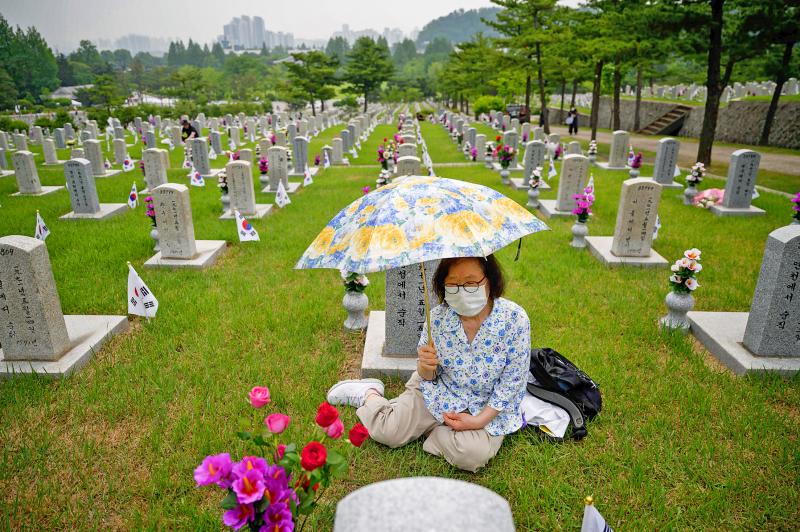
Photo: AFP 照片:法新社
Two Koreas created
The Soviet Union declared war on Japan, Korea’s colonial ruler, between the US nuclear strikes on Hiroshima and Nagasaki in August 1945, and sent troops pouring into the peninsula.
Washington and Moscow agreed to divide it into two occupied zones along the 38th parallel, a line of latitude that splits the territory roughly across the middle.
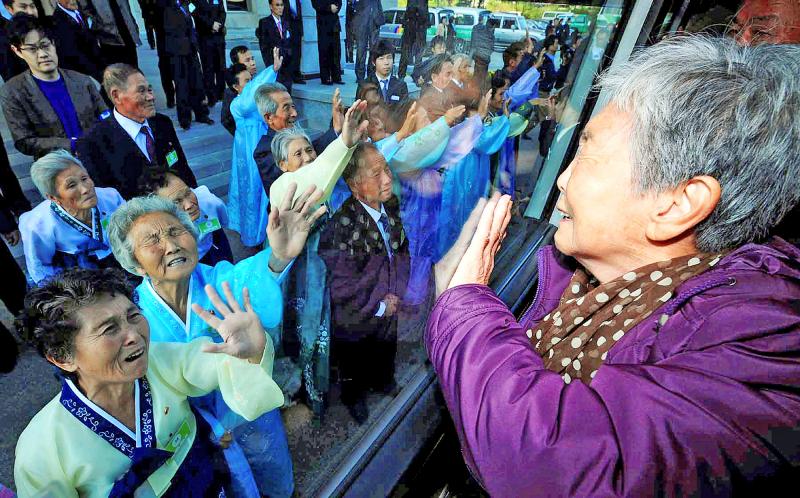
Photo: Reuters 照片:路透
Two rival states emerged in 1948. In Seoul, the capital of the South, the Harvard — and Princeton — educated Syngman Rhee led a US-oriented regime. Moscow appointed Kim Il Sung, who had led a Korean contingent in the Soviet army, as head of the North. His son and grandson have since retained an absolute grip on power in Pyongyang.
Both the communist North and the capitalist South claimed to be the legitimate government of the entire peninsula.
Invasion and counter-attack
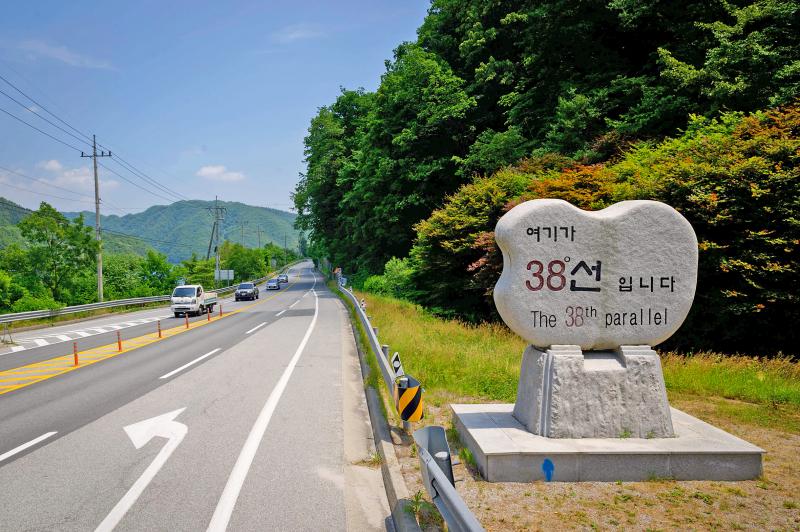
Photo: AFP 照片:法新社
On June 25, 1950, the North invaded the South as Kim Il Sung attempted to reunify Korea by force. The UN Security Council authorized armed intervention in support of the South — Moscow did not veto the resolution as it was boycotting the body. But the South’s forces crumbled before the Northern advance, and Pyongyang’s army seized Seoul just three days after crossing the 38th parallel.
Multinational UN forces, led by the US, arrived in the South to help. But they were pushed back to the Pusan Perimeter, a pocket on the peninsula’s southeastern tip, around the city now known as Busan.
The Incheon Landing — a bold counter-offensive launched in the city to the west of Seoul — recaptured the capital, split the North’s forces and turned the tide. UN units swept north, seized Pyongyang on Oct. 19 and advanced almost to the Chinese border.
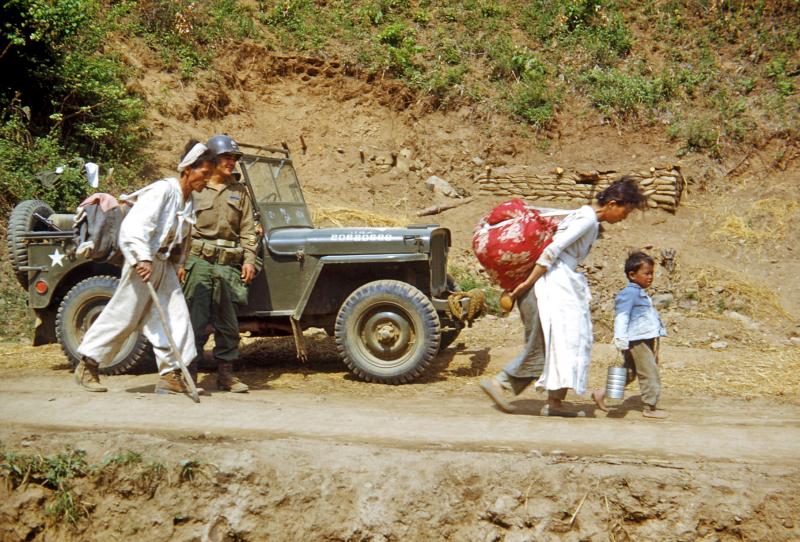
Photo: EPA-EFE 照片:歐新社
But Pyongyang’s allies reversed the war’s course again as Beijing sent hundreds of thousands of troops to help. Seoul fell to them again in January 1951, only for the UN coalition to recapture it once more two months later — the fourth time the city had changed hands.
Armistice
By June the front line had stabilized roughly where the Demilitarized Zone runs today — not far from the pre-war division along the 38th parallel. Another two years of attrition — accompanied by large-scale US bombing of the North, despite Moscow providing air power — followed as the fighting wore its way to a stalemate.
After more than two years of truce talks and 158 meetings, an armistice was finally signed in July 1953 by North Korea, China and the UN Command. But Rhee, who still wanted to defeat the North, refused to sign.
The longest ceasefire
The ceasefire was supposed to be replaced with a final peace settlement, but that has never happened.
Washington still stations 28,500 troops in the South, while the North — which has the world’s largest standing army — has spent decades developing nuclear weapons and long-range missiles, saying it needs them to deter a US invasion.
It has been isolated internationally as a result, and subject to multiple sets of UN Security Council sanctions. Both Pyongyang and Seoul continue to claim sovereignty over the whole Korean peninsula.
(AFP)
六月二十五日是韓戰爆發七十週年。處於冠狀病毒疫情中的南北韓,皆低調舉行紀念活動。這也是北韓突然停止對南韓施壓之次日。
韓戰不僅是南北韓間之對抗,也把雙方各自的共產主義國家與西方國家盟友捲入──蘇聯和中國支持平壤,以美國為首、打著聯合國旗號的聯盟則支持首爾。
韓戰在一九五○年六月二十五日爆發,造成多達三百萬名韓國人死亡(其中大多數為平民),最後以停火,而非和平條約結束,這使兩韓在技術上仍處於戰爭狀態。
創建了兩個韓國
一九四五年八月,在美國分別對廣島和長崎投下核彈之間,蘇聯向朝鮮的殖民國日本宣戰,並派出大量兵力進入朝鮮半島。
華盛頓與莫斯科同意以北緯三十八度線將朝鮮半島劃分為兩個佔領區,這條緯線大致橫切過半島中央,將其一分為二。
兩個敵對的國家在一九四八年出現。在南韓首府首爾,曾於哈佛及普林斯頓大學受教育的李承晚領導親美的政權。莫斯科任命金日成擔任北韓之首腦,金日成曾在蘇聯軍隊中率領一支朝鮮部隊。此後,金日成之兒孫在平壤都保有絕對的控制權。
共產主義國家北韓與資本主義國家南韓,都宣稱自己是整個朝鮮半島的合法政府。
入侵與反擊
一九五○年六月二十五日,北韓入侵南韓,金日成試圖以武力統一韓國。聯合國安理會授權進行武裝干預,以支持南韓──莫斯科並未對此決議行使否決權,因其當時正抵制安理會而未與會。不過南韓部隊在北韓推進前便已潰不成軍,平壤的軍隊在跨越北緯三十八度線僅三天之後,便佔領了首爾。
以美國為首的聯合國多國部隊抵達南韓救援。但他們被逼退至釜山環形防禦圈,即位於朝鮮半島東南端今釜山市周圍的一小塊地區。
仁川登陸──在首爾以西的這座城市所發動的大膽反攻──奪回了首都、分散了北韓兵力,並扭轉了情勢。聯合國部隊向北掠去,在十月十九日占領了平壤,並幾乎推進到了北韓與中國接壤處。
但北京派數十萬救兵來援──平壤的盟國再次扭轉了戰爭的進程。一九五一年一月,首爾再次落入北韓手中,只不過兩個月後,聯合國聯軍又再次攻下南韓首都──這是首爾第四度易手。
停戰
到了六月,前線已大致穩定在現今南北韓非軍事區所在處,距離戰前南北韓分界線北緯三十八度線不遠。戰爭再度陷入僵局之後,又經歷了兩年的消耗──其間美國對北韓進行大規模轟炸,儘管莫斯科亦提供北韓空軍支援。
經過兩年多的休戰談判與一百五十八次會議,北韓、中國及聯合國軍終於在一九五三年七月簽署了停戰協定。但仍然想打敗北韓的李承晚拒絕簽署。
最長的停火
停火應以最終之和平解決方案代之,但這從未發生。
華盛頓仍在南韓部署兩萬八千五百名軍人,而擁有世界上最大常備軍的北韓則花了數十年發展核子武器與遠程飛彈,稱需要它們來嚇阻美國的入侵。
結果,北韓在國際上被孤立,並受到聯合國安理會多套制裁。平壤及首爾皆繼續聲稱對整個朝鮮半島擁有主權。
(台北時報林俐凱編譯)
FOLLOW UP 讀後練習
Did you know?
The Korean War might seem geographically distant from Taiwan, however it made the US reverse its hands-off policy toward the then-Chinese Nationalist Party (KMT) government on Taiwan. Washington sent the US Seventh Fleet to the Taiwan Strait to put the island under US protection.
US support deterred the Chinese Communist Party from launching an invasion of Taiwan, which it had drawn up plans for prior to the outbreak of the Korean War in 1950.
(Lin Lee-kai, Taipei Times)

In an effort to fight phone scams, British mobile phone company O2 has introduced Daisy, an AI designed to engage phone con artists in time-wasting conversations. Daisy is portrayed as a kindly British granny, exploiting scammers’ tendency to target the elderly. Her voice, based on a real grandmother’s for authenticity, adds to her credibility in the role. “O2” has distributed several dedicated phone numbers online to direct scammers to Daisy instead of actual customers. When Daisy receives a call, she translates the scammers’ spoken words into text and then responds to them accordingly through a text-to-speech system. Remarkably, Daisy
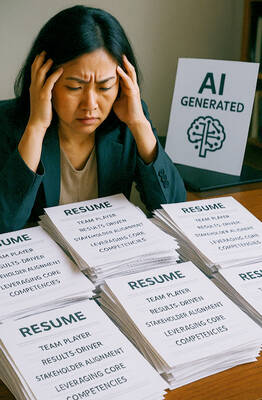
Bilingual Story is a fictionalized account. 雙語故事部分內容純屬虛構。 Emma had reviewed 41 resumes that morning. While the ATS screened out 288 unqualified, she screened for AI slop. She could spot it a mile away. She muttered AI buzzwords like curses under her breath. “Team player.” “Results-driven.” “Stakeholder alignment.” “Leveraging core competencies.” Each resume reeked of AI modeling: a cemetery of cliches, tombstones of personality. AI wasn’t just changing hiring. It was draining the humanity from it. Then she found it: a plain PDF cover letter. No template. No design flourishes. The first line read: “I once tried to automate my

Every May 1, Hawaii comes alive with Lei Day, a festival celebrating the rich culture and spirit of the islands. Initiated in 1927 by the poet Don Blanding, Lei Day began as a tribute to the Hawaiian custom of making and wearing leis. The idea was quickly adopted and officially recognized as a holiday in 1929, and leis have since become a symbol of local pride and cultural preservation. In Hawaiian culture, leis are more than decorative garlands made from flowers, shells or feathers. For Hawaiians, giving a lei is as natural as saying “aloha.” It shows love and

1. 他走出門,左右看一下,就過了馬路。 ˇ He walked outside, looked left and right, and crossed the road. χ He walked outside and looked left and right, crossed the road. 註︰並列連接詞 and 在這句中連接三個述語。一般的結構是 x, y, and z。x and y and z 是加強語氣的結構,x and y, z 則不可以。 2. 他們知道自己的弱點以及如何趕上其他競爭者。 ˇ They saw where their weak points lay and how they could catch up with the other competitors. χ They saw where their weak points lay and how to catch up with the other competitors. 註:and 一般連接同等成分,結構相等的單詞、片語或子句。誤句中 and 的前面是子句,後面是不定詞片語,不能用 and 連接,必須把不定詞片語改為子句,and 前後的結構才相等。 3. 她坐上計程車,直接到機場。 ˇ She took a cab, which took her straight to the airport. ˇ She took a cab and it took her straight